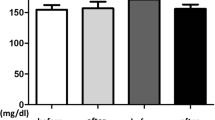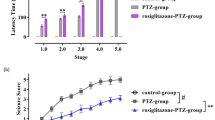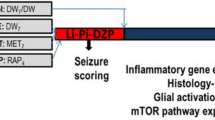Abstract
Epilepsy is commonly associated with cognitive impairment. Astrocyte activation and oxidative stress occur following seizures, and play a role in the pathological injury of epilepsy with cognitive impairment. The peroxisome proliferator-activated receptor gamma (PPARγ) has been shown to exhibit neuroprotective and antioxidative effects in CNS diseases. Thus, we hypothesized that rosiglitazone, a PPARγ agonist, would prevent cognitive impairment by inhibiting astrocyte activation and regulating glutathione (GSH) homeostasis after status epilepticus (SE). Using a lithium pilocarpine-induced SE model, we found that rosiglitazone significantly prevented cognitive impairment induced by SE, and potently inhibited astrocyte activation with maintenance of GSH homeostasis in the hippocampus after SE. These protective effects were significantly reversed by co-treatment with the PPARγ antagonist T0070907. These data suggest that rosiglitazone can improve cognitive impairment, and inhibit astrocyte activation and oxidative damage following SE. Rosiglitazone may be a promising agent for treatment of epilepsy involving SE-induced cognitive impairment.





Similar content being viewed by others
References
Motamedi G, Meador K (2003) Epilepsy and cognition. Epilepsy Behav Suppl 2:S25–S38
Wojtowicz JM (2008) Potential consequences of altered neurogenesis on learning and memory in the epileptic brain. Epilepsia Suppl 5:42–49
Lee JK, Won JS, Singh AK, Singh I (2008) Statin inhibits kainic acid-induced seizure and associated inflammation and hippocampal cell death. Neurosci Lett 440:260–264
Pestana RR, Kinjo ER, Hernandes MS, Britto LR (2010) Reactive oxygen species generated by NADPH oxidase are involved in neurodegeneration in the pilocarpine model of temporal lobe epilepsy. Neurosci Lett 484:187–191
Elsharkawy AE, Alabbasi AH, Pannek H, Oppel F, Schulz R, Hoppe M, Hamad AP, Nayel M, Issa A, Ebner A (2009) Long-term outcome after temporal lobe epilepsy surgery in 434 consecutive adult patients. J Neurosurg 110:1135–1146
Swann JW (2004) The effects of seizures on the connectivity and circuitry of the developing brain. Ment Retard Dev Disabil Res Rev. 10:96–100
Jansson L, Wennström M, Johanson A, Tingström A (2009) Glial cell activation in response to electroconvulsive seizures. Prog Neuropsychopharmacol Biol Psyc 33:1119–1128
Nihal C, de Lanerolle, Lee TS, Spencer DD (2010) Astrocytes and epilepsy. Neurotherapeutics 7:424–438
Ricci G, Volpi L, Pasquali L, Petrozzi L, Siciliano G (2009) Astrocyte-neuron interactions in neurological disorders. J Biol Phys 35:317–336
Agarwal NB, Agarwal NK, Mediratta PK, Sharma KK (2011) Effect of lamotrigine, oxcarbazepine and topiramate on cognitive functions and oxidative stress in PTZ-kindled mice. Seizure 20:257–262
Freitas RM (2009) Investigation of oxidative stress involvement in hippocampus in epilepsy model induced by pilocarpine. Neurosci Lett 462:225–229
Turner DA, Adamson DC (2011) Neuronal-astrocyte metabolic interactions: understanding the transition into abnormal astrocytoma metabolism. J Neuropathol Exp Neurol 70:167–176
Hirrlinger J, Dringen R (2010) The cytosolic redox state of astrocytes: Maintenance regulation and functional implications for metabolite trafficking. Brain Res Rev 63:177–188
Lee YH, Lee NH, Bhattarai G, Yun JS, Kim TI, Jhee EC, Yi HK (2010) PPARgamma inhibits inflammatory reaction in oxidative stress induced human diploid fibloblast. Cell Biochem Funct 28:490–496
Uryu S, Harada J, Hisamoto M, Oda T (2002) Troglitazone inhibits both post-glutamate neurotoxicity and low-potassium-induced apoptosis in cerebellar granule neurons. Brain Res 924:229–236
Sun H, Huang Y, Yu X, Li YN, Yang J, Li R, Deng YC, Zhao G (2008) Peroxisome proliferator-activated receptor gamma agonist, rosiglitazone, suppresses CD40 expression and attenuates inflammatory responses after lithium pilocarpine-induced status epilepticus in rats. Int J Devl Neurosci 26:505–515
Yu X, Shao XG, Sun H, Li YN, Yang J, Deng YC, Huang YG (2008) Activation of cerebral peroxisome proliferator-activated receptors gamma exerts neuroprotection by inhibiting oxidative stress following pilocarpine-induced status epilepticus. Brain Res 1200:146–158
Racine RJ (1972) Modification of seizure activity by electrical stimulation: IIR Motor seizure Electroencephalogr. Clin Neurophysiol 32:281–294
Becker A, Grecksch G, Thiemann W, Hoellt V (2000) Pentylentetrazolkindling modulates stimulated dopamine release in the nucleus accumbens. Pharmacol Biochem Behav 66:425–428
Winters RA, Zukowski J, Ercal N, Matthews RH, Spitz DR (1995) Analysis of glutathione, glutathione disulfide, cysteine, homocysteine, and other biological thiols by high-performance liquid chromatography following derivatization with N-(1-pyrenyl) maleimide. Anal Biochem 227:14–21
Pouzet B, Zhang WN, Feldon J, Rawlins JN (2002) Hippocampaln lesioned rats are able to learn a spatial position using non-spatial strategies. Behav Brain Res 133:279–291
Jung KH, Chu K, Lee ST, Kim JY, Sinn DI, Kim JM, Park DK, Lee JJ, Kim SU, Kim M, Lee SK, Roha JK (2006) Cyclooxygenase-2 inhibitor, celecoxib, inhibits the altered hippocampal neurogenesis with attenuation of spontaneous recurrent seizures following pilocarpine-induced status epilepticus. Neurobiol Dis 23:237–246
Vijayaraghavan L, Natarajan S, Krishnamoorthy ES (2011) Peri-ictal and ictal cognitive dysfunction in epilepsy. Behav Neurol 24:27–34
Ding S, Fellin T, Zhu Y, Lee SY, Auberson YP, Meaney DF, Coulter DA, Carmignoto G, Haydon PG (2007) Enhanced astrocytic Ca2+ signals contribute to neuronal excitotoxicity after status epilepticus. J Neurosci 27:10674–10684
Gómez-Gonzalo M, Losi G, Chiavegato A, Zonta M, Cammarota M, Brondi M, Vetri F, Uva L, Pozzan T, de Curtis M, Ratto GM, Carmignoto G (2010) An excitatory loop with astrocytes contributes to drive neurons to seizure threshold. PLoS Biol 8:e1000352
Waldbaum S, Liang LP, Patel M (2010) Persistent impairment of mitochondrial and tissue redox status during lithium-pilocarpine-induced epileptogenesis. J Neurochem 115:1172–1182
Peternel S, Pilipović K, Zupan G (2009) Seizure susceptibility and the brain regional sensitivity to oxidative stress in male and female rats in the lithium-pilocarpine model of temporal lobe epilepsy. Prog Neuropsychopharmacol Biol Psyc 33:456–462
Abe K, Nakanishi K, Saito H (2000) The possible role of endogenous glutathione as an anticonvulsant in mice. Brain Res 854:235–238
Sain H, Sharma B, Jaggi AS (2011) Singh N Pharmacological investigations on potential of peroxisome proliferator-activated receptor-gamma agonists in hyperhomocysteinemia-induced vascular dementia in rats. Neuroscience
Kaur B, Singh N, Jaggi AS (2009) Exploring mechanism of pioglitazone-induced memory restorative effect in experimental dementia. Fundam Clin Pharmacol 23:557–566
Kim EK, Kown KB, Koo BS, Han MJ, Song MY, Song EK, Han MK, Park JW, Ryu DG, Park BH (2007) Activation of perxisome proliferator-activated receptor-gamma protects pancreatic beta-cells from cytokine-induced cytotoxicity via NF kappaB pathway. Int J Biochem Cell Biol 39:1260–1275
Yuan L, Kaplowitz N (2009) Glutathione in liver diseases and hepatotoxicity. Mol Aspects Med 30:29–41
Hirrlinger J, Dringen R (2010) The cytosolic redox state of astrocytes: maintenance regulation and functional implications for metabolite trafficking. Brain Res Rev 63:177–188
de Lanerolle NC, Lee TS, Spencer DD (2010) Astrocytes and epilepsy. Neurotherapeutics 7:424–438
Zhao CS, Overstreet-Wadiche L (2008) Integration of adult generated neurons during epileptogenesis. Epilepsia Suppl 5:3–12
Sauerbeck A, Gao J, Readnower R, Liu M, Pauly JR, Bing G, Sullivan PG (2011) Pioglitazone attenuates mitochondrial dysfunction cognitive impairment, cortical tissue loss, and inflammation following traumatic brain injury. Exp Neurol 227:128–135
Kaundal RK, Sharma SS (2011) GW1929: a nonthiazolidinedione PPARγ agonist ameliorates neurological damage in global cerebral ischemic-reperfusion injury through reduction in inflammation and DNA fragmentation. Behav Brain Res 216:606–612
Rodriguez-Rivera J, Denner L, Dineley KT (2011) Rosiglitazone reversal of Tg2576 cognitive deficits is independent of peripheral gluco-regulatory status. Behav Brain Res 216:255–261
Jiang Q, Heneka M, Landreth GE (2008) The role of peroxisome proliferator-activated receptor-gamma (PPARgamma) in Alzheimer’s disease: therapeutic implications. CNS Drugs 22:1–14
Arif H, Buchsbaum R, Weintraub D, Pierro J, Resor SR Jr, Hirsch LJ (2009) Patient-reported cognitive side effects of antiepileptic drugs: predictors and comparison of all commonly used antiepileptic drugs. Epilepsy Behav 14:202–209
Acknowledgments
This study was supported by the “Taiwan Guang Hua Fund”. We thank Dr. Dong Yan (Department of Immunology, Xijing Hospital) for his valuable technical advice.
Author information
Authors and Affiliations
Corresponding author
Rights and permissions
About this article
Cite this article
Hong, S., Xin, Y., HaiQin, W. et al. The PPARγ agonist rosiglitazone prevents cognitive impairment by inhibiting astrocyte activation and oxidative stress following pilocarpine-induced status epilepticus. Neurol Sci 33, 559–566 (2012). https://doi.org/10.1007/s10072-011-0774-2
Received:
Accepted:
Published:
Issue Date:
DOI: https://doi.org/10.1007/s10072-011-0774-2




